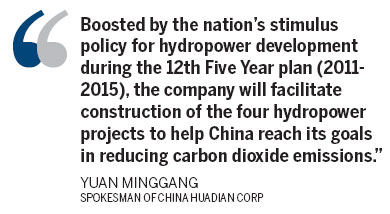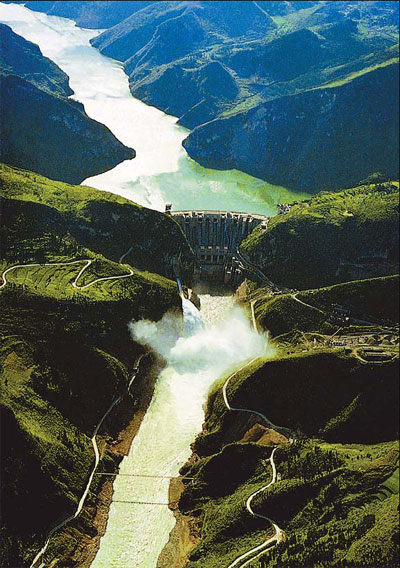Hydro powering clean energy growth
|
With an installed capacity of 1.25 million kW, Wujiangdu Hydropower Station is China's first large power plant built in karst formations and the first with capacity above 1 million kW in Guizhou province. Provided to China Daily |
Huadian Corp plans four new stations to generate 10m kW
China Huadian Corp (CHD), one of the nation's major power producers, plans to build four new hydropower stations across the country in the next five years that would increase its installed capacity by 10 million kW.
It aims to have 26 million kW of installed hydropower capacity by 2015, which would account for 8 percent of the national total, the company said in its first Hydropower Sustainability Report released recently in Beijing.
Blueprints call for new projects on the upper and middle stretches of the Jinshajiang River as well as the Wujiang and Nujiang rivers, company spokesman Yuan Minggang told a media briefing.
"Boosted by the nation's stimulus policy for hydropower development during the 12th Five Year plan (2011-2015), the company will facilitate construction of the four hydropower projects to help China reach its goals in reducing carbon dioxide emissions," said Yuan.
The reports said the company's total installed hydropower capacity hit 15.38 million kW by the end of 2010, accounting for 7.3 percent of the nation's total and 17 percent of the company's energy mix.
By 2020, more than half of the nation's non-fossil energy generation will come from hydropower, Zhang Guobao, the former energy minister said earlier this month.
Renewable energy now accounts for 8 percent of China's total consumption, a number the country intends to increase to 15 percent by 2020.
China will try to cut its energy intensity - the amount of energy consumed and carbon dioxide emitted in every unit of gross domestic product - by 16 percent to 17 percent from this year to the end of 2015, Xinhua reported last week.
As the nation strives to increase clean energy's share of the total power mix, hydropower tops the agenda at the nation's major power producers due to its obvious benefits.
Impacts, protection
After a big initial outlay, hydro projects tend to have a good payback ratio due to their longevity and low running costs, industry experts say.
Hydropower accounts for 20 percent of the world's electricity, making it by far the biggest source of renewable energy.
But the sector certainly has its critics.
Hydropower stations inevitably destroy the homes and livelihoods of thousands of people living in the area and have also a big impact on local flora and fauna.
Some proposed hydropower projects are said to be "real-life Avatar" stories - a reference to the blockbuster movie that depicted an environment and people threatened by development.
The impact on local residents and ecosystems is now a hurdle for builders of large hydropower projects.
Aware of the pressing issue, CHD built a 35 million yuan ($5.39 million) fish breeding and reproduction center in 2009 as part of its hydropower project on the Wujiang River in Southwest China's Guizhou province.
It has since raised more than 20 species of rare and endangered fish and released them into the river.
The company also built a nature reserve for endangered species including the rhesus monkey near the dam's reservoir.
China is home to the world's biggest hydroelectric project - the $23 billion Three Gorges Dam on the Yangtze River completed in 2006. In recent months several other major projects have been given the go-ahead.
They include a controversial $1.2 billion project to build the world's highest dam in Tibet on the Yarlung Zangbo River, which is due to be completed in 2014.
Another project with recent government approval is the $3.3 billion Changheba Hydropower Plant in Sichuan province to be built by Datang International Power Generation Corp.
Now the world's top energy producer and user, China's consumption totaled 3.25 billion tons of coal equivalent last year, up 5.9 percent from 2009.
The nation will cap its energy use at 4 billion metric tons of coal equivalent by 2015 and raise the share of non-fossil fuels in the energy mix to 11.4 percent under plans due for approval at the National People's Congress.
Zhang said that under the new plan, growth in energy consumption would average 4.24 percent annually over the next five years. The previous five-year plan had a renewable target of 10 percent, which was not met.
China Daily

(China Daily 05/10/2011 page15)















